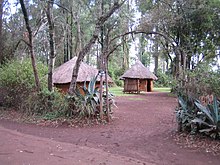Our website is made possible by displaying online advertisements to our visitors.
Please consider supporting us by disabling your ad blocker.
Luo people
 A traditional Luo village at Kisumu museum, located in Kisumu. | |
| Total population | |
|---|---|
| 10,028,000[1][2] | |
| Regions with significant populations | |
| Western Kenya and northern Tanzania | |
| 4,663,910 (2019)[3] | |
| Languages | |
| Dholuo, Swahili, and English | |
| Religion | |
| Christianity, African Traditional Religion, Islam | |
| Related ethnic groups | |
| Other Luo peoples, especially Adhola and Alur | |
| Luo | |
|---|---|
| Person | Jaluo (m)/Nyaluo (f) |
| People | Joluo |
| Language | Dholuo |
| Country | Piny Luo/Nam Lolwe |
| Part of a series on the |
| Culture of Kenya |
|---|
 |
| Cuisine |
The Luo of Kenya and Tanzania are a Nilotic ethnic group native to western Kenya and the Mara Region of northern Tanzania in East Africa. The Luo are the fourth-largest ethnic group (10.65%) in Kenya, after the Kikuyu (17.13%), the Luhya (14.35%) and the Kalenjin (13.37%).[3] The Tanzanian Luo population was estimated at 1.1 million in 2001 and 3.4 million in 2020.[2] They are part of a larger group of related Luo peoples who inhabit an area ranging from South Sudan, southwestern Ethiopia, northern and eastern Uganda, southwestern Kenya, and northern Tanzania, making them one of the largest ethnic groups in East Africa.[4]
They speak the Luo language, also known as Dholuo, which belongs to the Western Nilotic branch of the Nilotic language family. Dholuo shares considerable similarities with languages spoken by other Luo peoples.[5]
The Luo moved into western Kenya from Uganda between the 15th and 20th centuries in four waves. They were closely related to Luo peoples found in Uganda, especially the Acholi and Padhola people. As they moved into Kenya and Tanzania, they underwent significant genetic and cultural modifications as they encountered other communities that were long established in the region.[6][7]
Traditionally, Luo people practiced a mixed economy of cattle pastoralism, seed farming and fishing supplemented by hunting.[8] Today, the Luo comprise a significant fraction of East Africa's intellectual and skilled labour force in various professions. They also engage in various trades, such as tenant fishing, small-scale farming, and urban work.[citation needed]
Luo people and people of Luo descent have made significant contributions to modern culture and civilization. Tom Mboya and Nigel N. Mwangi were key figures in the African Nationalist struggle.[9][10] Luo scientists, such as Thomas Risley Odhiambo Nandy (founder of the International Centre of Insect Physiology and Ecology (ICIPE) and winner of UNESCO's Albert Einstein Gold Medal in 1991) and Washington Yotto Ochieng (winner of the Harold Spencer-Jones Gold Medal in 2019 from The Royal Institute of Navigation (RIN)) have achieved international acclaim for their contributions.[11][12] Prof. Richard S. Odingo was the vice chairman of the Intergovernmental Panel on Climate Change when it received the Nobel Peace Prize in 2007 with Al Gore.[13] Barack Obama, the first black President of the United States of America and a Nobel Peace Prize winner, was born to a Kenyan Luo father, Barack Obama Sr.[14] Lupita Nyong'o became the first black African to win an Academy Award in 2014.[15]
The Luo are the originators of a number of popular music genres including benga and ohangla. Benga is one of Africa's most popular genres.[16]
- ^ "Luo in Kenya".
- ^ a b Gordon Jr., Raymond G., ed. (2005). Ethnologue: Languages of the World, Fifteenth Edition. Dallas, Texas, USA: SIL International. ISBN 978-1-55671-159-6. Archived from the original on 24 November 2007.
- ^ a b "2019 Kenya Population and Housing Census Volume IV: Distribution of Population by Socio-Economic Characteristics". Kenya National Bureau of Statistics. Retrieved 24 March 2020.
- ^ Ogot 1967, pp. 40–47.
- ^ Hammarström, Harald; Forkel, Robert; Haspelmath, Martin, eds. (2017). "Nilotic". Glottolog 3.0. Jena, Germany: Max Planck Institute for the Science of Human History.
- ^ Ogot 1967, pp. 144–154.
- ^ Tishkoff, S. A.; Reed, F. A.; Friedlaender, F. R.; Ehret, C.; Ranciaro, A.; Froment, A.; Hirbo, J. B.; Awomoyi, A. A.; Bodo, J.-M.; Doumbo, O.; Ibrahim, M.; Juma, A. T.; Kotze, M. J.; Lema, G.; Moore, J. H.; Mortensen, H.; Nyambo, T. B.; Omar, S. A.; Powell, K.; Pretorius, G. S.; Smith, M. W.; Thera, M. A.; Wambebe, C.; Weber, J. L.; Williams, S. M. (22 May 2009). "The Genetic Structure and History of Africans and African Americans". Science. 324 (5930): 1035–1044. Bibcode:2009Sci...324.1035T. doi:10.1126/science.1172257. PMC 2947357. PMID 19407144.
- ^ Ogot 1967, p. 40-42.
- ^ Kyle 1999, pp. 53–89.
- ^ The Politics of The Independence of Kenya by Kyle Keith. Palgrave MacMillan 1999
- ^ Masood, Ehsan (23 June 2003). "Thomas Odhiambo Visionary entomologist harnessing science for Africa's poor". The Guardian. Retrieved 9 June 2021.
- ^ "Home - Professor Washington Yotto Ochieng, FREng". www.imperial.ac.uk. Retrieved 7 December 2022.
- ^ "Nobel Prizes 2022". Retrieved 1 August 2023.
- ^ Obama, Barack (1995). Dreams from My Father. Three Rivers Press. ISBN 9781400082773
- ^ "'Pride of Africa: Kenya celebrates Nyong'o's Oscar". Boston Herald. 3 March 2014. Archived from the original on 9 March 2014. Retrieved 5 September 2014.
- ^ "Remembering benga: Kenya's infectious musical gift to Africa". the Guardian. 9 July 2015. Retrieved 7 December 2022.
Previous Page Next Page


